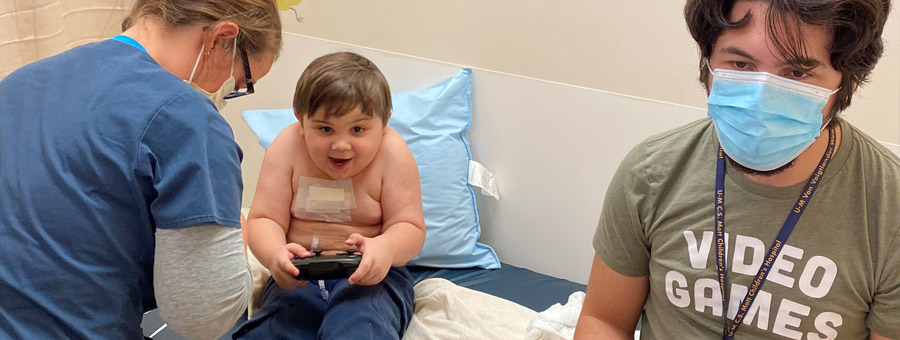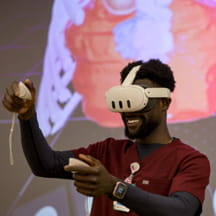At the age of 7, J.J. Bouchard was diagnosed with Type 1 diabetes and spent a week at University of Michigan Health C.S. Mott Children’s Hospital.
It was there that he was first introduced to video games. “It was basically the only good thing that I felt happened to me while I was there,” Bouchard says.
Twenty years later, Bouchard was back at Mott—this time as a recreational therapist working in the hospital’s activity room. Video games were not readily available for the hospital’s patients, but Bouchard knew how impactful they could be.
“I remembered how helpful video games were for me,” says Bouchard, CCLS, CTRS, manager of patient technology, child life assistants and therapeutic recreation at C.S. Mott Children’s Hospital in Ann Arbor, Michigan. “So, I started incorporating them into my own therapeutic practice.”
Technology promotes health in multiple ways
Today, Bouchard oversees Mott’s Therapeutic Gaming and Digital Technology program. He and his team work closely with patients and their families to provide video games, augmented reality (AR) and virtual reality (VR) experiences to help kids combat boredom and serve as a distraction from painful or uncomfortable procedures, such as receiving shots or stitches.
They also coordinate with patient care teams to determine how technology can be tailored to each child’s medical needs and goals toward improved medical outcomes. The benefits of the program include:
- Mobility. Patients exercise fine and gross motor skills using video game controllers and experiencing VR applications. The Mott team also uses hospital-based AR games, such as Pokémon Go, to encourage patient movement.
- Mental stimulation. In addition to the problem solving inherent in video games, patient technology specialists help kids learn coding, create video games and build robotic kits.
- Socialization. Group or team games allow kids to make new friends with fellow patients.
- Normalization. Many patients bring their own video game consoles with them to the hospital, allowing them to stay connected with their friends and family.
Bouchard says the program’s work—whether it’s a gaming volunteer simply playing a game with a patient or helping a physical therapist integrate VR into a patient’s therapeutic plan—is integral to the overall patient experience.
“I would say it's crucial,” Bouchard says. “The technology we provide helps a child still feel human. To have the things they love available and accessible keeps them grounded and helps motivate them to get better.”
Gaming program plays key infrastructure role
Mott’s therapeutic gaming and digital experience program also serves as an important complement to the hospital’s IT team. Because much of the time and expertise of Bouchard’s team is dedicated to helping patients and their families integrate their devices within the hospital’s network, it frees the IT unit to focus on maintaining the facility’s mission-critical technology.
Bouchard says there’s no better example of the value of that relationship than when the pandemic forced schools to move to virtual learning, which meant Mott’s patients needed to connect to their school’s platform from within the hospital.
“Our IT team was being overwhelmed with calls from people needing help setting up their computers,” Bouchard says. “My team was able to troubleshoot that because they were familiar working with people's personal computers and were able to talk with all the school systems to make sure every kid’s laptop could connect with their school.”



